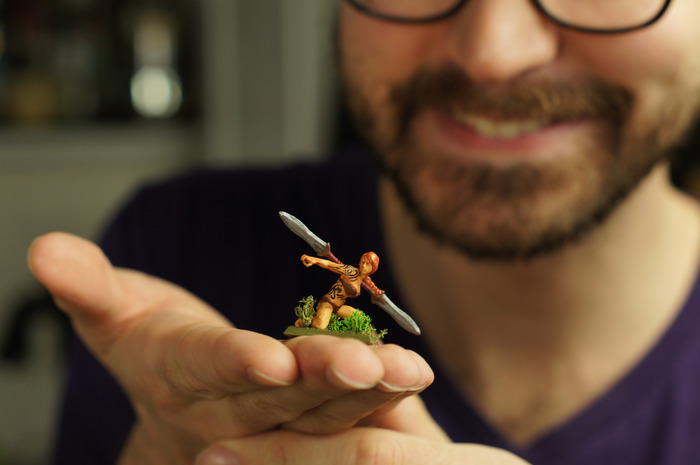
A painted miniature produced by Hero Forge’s custom design service. Courtesy of Hero Forge.
January 15, 2014
A shift is coming to additive manufacturing (AM). Where AM systems were previously used mainly for prototyping or small part run needs, more and more of the business of AM is turning to end-use products. Whether it’s printed aerospace parts by the thousands or print-on-demand services from service bureaus, expect to see more 3D printed products in the future.
Of course, not every end-use product has to be serious business. Plenty of the designs on display at Shapeways are little more than novelty items. It makes perfect sense that some companies would turn to AM to create custom products for smaller market segments. Hero Forge is looking to use 3D printing to custom build miniatures for tabletop gaming.

Get all of the people living in their mother’s basement jokes out of your system. The audience Hero Forge is aiming for has been a steady market since the 1970s. The past few years have seen record attendance numbers for GenCon, the industry’s big convention held annually in Indianapolis. While some of the businesses involved in tabletop gaming have switched to a mainly digital delivery system, others, like Games Workshop, still rely mainly on brick-and-mortar stores with physical products to drive its multi-million dollar a year business.
Hero Forge is hoping to tap the demands of its customers for specific character models, or models with an unusual appearance, by offering a print-on-demand service. Customers would visit the company’s website and design the exact model they prefer using a simple swap-based design tool. Hero Forge then uses what looks to be stereolithography to build the model, including an option for increasing the scale.
From the Kickstarter page:
Print on demand means you’re not limited to what big companies think have the broadest appeal, and we don’t have to exclude poses, equipment, or designs simply because they can’t be made with injection molds. This means more freedom for you. Interior or recessed detail, which is notoriously difficult for injection molds, is easy with 3D printing. We can also offer certain novel options like printing segmented chains or swinging lanterns with articulated parts, no assembly required.
Even if you aren’t particularly excited by the notion of printing out your very own orc thief, the potential offered by 3D printing that Hero Forge is attempting to capture is the direction AM is moving. With 3D printed wearable electronics on the horizon, the possibility of AM-built phones, and many other end-use options coming, more 3D printed products than ever will be finding their way into the hands of customers.
Below you’ll find Hero Forge’s Kickstarter video.
Source: Kickstarter
Subscribe to our FREE magazine, FREE email newsletters or both!
About the Author
John NewmanJohn Newman is a Digital Engineering contributor who focuses on 3D printing. Contact him via [email protected] and read his posts on Rapid Ready Technology.
Follow DE





